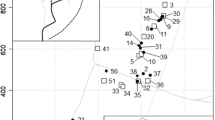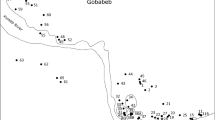Summary
In Australian ants of the Rhytidoponera impressa group there are two distinct types of colonies which occur sympatrically in most species: monogynous, queenright colonies (Type A), and monogynous or (usually) polygynous worker-reproductive colonies (Type B) in which 1–15 (mean 4.0) mated workers occur in lieu of a queen.
Both colonies produce winged males, and Type A colonies also rear numerous colony-founding alate queens. Type B colonies seldom produce queens and usually reproduce by colony fission (budding off daughter colonies with one or more mated workers). In Rhytidoponera confusa and chalybaea there is no evidence of reproductive isolation between the two colony types: allele frequencies at several polymorphic enzyme loci are essentially identical in sympatric Type A and Type B colonies, despite marked genetic differentiation among geographically distinct populations and between species.
Allozyme markers confirm that the queen in Type A colonies mates only once and is the mother of all colony members, including males. Regression estimates of relatedness among workers (w) and males (m) in queenright colonies give b w.w≈0.70 and b m.w≈0.20. Corresponding estimates for Type B colonies (b w.w≈0.30, b m.w≈0.16) reveal lower levels of relatedness. Cohabiting mated workers are often closely related, and share reproductive output approximately equally. Uninseminated laying workers are found in about one-quarter of Type B colonies.
Workers in Type A colonies behave more aggressively during colony disturbance than non-reproductive workers in Type B colonies. Colony size, worker size, and male weights are significantly greater in Type A than Type B colonies. Despite evidence that worker altruism and ergonomic efficiency are better developed in Type A colonies, intra- and inter-specific comparisons within the genus Rhytidoponera indicate selective factors favoring worker-reproductive colonies over queenright colonies in xeric environments and in patchy mesic habitats.
Similar content being viewed by others
References
Alexander RD (1974) The evolution of social behavior. Annu Rev Ecol Syst 5:325–383
Brown WL (1953) Characters and synonymies among the genera of ants. Part I. Breviora 11:1–13
Brown WL (1958a) Contributions towards a reclassification of the Formicidae, II. Tribe Ectatommini (Hymenoptera). Bull Mus Comp Zool 118:175–362
Brown WL (1958b) A review of the ants of New Zealand. Acta Hymenopterol 1:1–50
Buschinger A, Winter U (1978) Echte Arbeiterinnen, fertile Arbeiterinnen, und sterile Wirtsweibchen in Völkern der dulotischen Ameise, Harpagoxenus sublaevis (Nyl.). Insectes Soc 25:63–78
Charlesworth B (1978) Some models of the evolution of altruistic behavior between siblings. J Theor Biol 72:297–317
Charlesworth B, Charnov EL (1981) Kin selection in age-structured populations. J Theor Biol 88:103–119
Charnov EL (1977) An elementary treatment of the genetical theory of kin selection. J Theor Biol 66:541–550
Craig R (1979) Parental manipulation, kin selection, and the evolution of altruism. Evolution 33:319–334
Craig R, Crozier RH (1979) Relatedness in the polygynous ant Myrmecia pilosula. Evolution 33:335–341
Crozier RH (1970) Coefficients of relationship and the identity of genes by descent in the Hymenoptera. Am Nat 104:216–217
Crozier RH (1974) Allozyme analysis of reproductive strategy in the ant Aphaenogaster rudis. Isozyme Bull 7:18
Crozier RH (1979) Genetics of sociality. In: Hermann HR (ed) Social insects, vol I. Academic Press, New York, pp 223–286
Crozier RH, Pamilo P (1980) Asymmetry in relatedness: who is related to whom? Nature 283:604
Hamilton WD (1964) The genetical evolution of social behaviour. J Theor Biol 7:1–52
Hamilton WD (1972) Altruism and related phenomena, mainly in social insects. Annu Rev Ecol Syst 3:193–232
Hamilton WD (1978) Evolution and diversity under bark. In: Mound LA, Waloff N (eds) Diversity of insect faunas. Symp R Entomol Soc (Lond) 9:154–175
Haskins CP (1979) Sexual calling behavior in highly primitive ants. Psyche 85:407–415
Haskins CP, Whelden RM (1965) “Queenlessness”, worker sibship, and colony versus population structure in the formicid genus Rhytidoponera. Psyche 72:87–112
Hölldobler B, Wilson EO (1977) The number of queens: an important trait in ant evolution. Naturwissenschaften 64:8–15
Kempf W (1971) A preliminary review of the ponerine ant genus Dinoponera Roger. Studia Entomol 14:369–394
LeMasne G (1956) La signification des reproducteurs aptères chez la fourmi Ponera eduardi Forel. Insectes Soc 3:239–259
Lester LJ, Selander RK (1981) Genetic relatedness and the social organization of Polistes. Am Nat 117:147–166
Malyshev SI (1968) Genesis of the Hymenoptera and the phases of their evolution. Methuen, London
Metcalf RA, Whitt GS (1977) Intra-nest relatedness in the social wasp, Polistes metricus. Behav Ecol Sociobiol 2:339–351
Michod RE (1982) The theory of kin selection. Annu Rev Ecol Syst 13:23–55
Michod RE, Hamilton WD (1980) Coefficients of relatedness in sociobiology. Nature 288:694–697
Orlove MJ (1975) A model of kin selection not invoking coefficients of relationship. J Theor Biol 49:289–310
Oster G, Wilson EO (1978) Caste and ecology in the social insects Princeton University Press, Princeton
Pamilo P (1981) Genetic organization of Formica sanguinea populations. Behav Ecol Sociobiol 9:45–50
Pamilo P (1982a) Genetic population structure in polygynous Formica ants. Herdity 48:95–106
Pamilo P (1982b) Multiple mating in Formica ants. Hereditas 97:37–45
Pamilo P, Crozier RH (1982) Measuring genetic relatedness in natural populations: methodology. Theor Popul Biol 21:171–193
Pamilo P, Varvio-Aho S (1979) Genetic structure of nests in the ant Formica sanguinea. Behav Ecol Sociobiol 6:91–98
Peeters CP (1982) The reproductive strategy of the ponerine Ophthalmopone berthoudi: an insight into the evolution of ant eusociality. In: Breed MD, Michener CD, Evans HE (eds) The biology of social insects. Westview Press, Boulder, pp 220–221 (Abstr)
Strassman J (1981) Evolutionary implications of early male and satellite nest production in Polistes exclamans colony cycles. Behav Ecol Sociobiol 8:55–64
Trivers RL, Hare H (1976) Haplodiploidy and the evolution of the social insects. Science 191:249–263
Uyenoyama MK, Feldman MW (1980) Theories of kin and group selection: a population genetics perspective. Theor Popul Biol 17:380–414
Uyenoyama MK, Feldman MW (1981) On relatedness and adaptive topography in kin selection. Theor Popul Biol 19:87–123
Uyenoyama MK, Feldman MW, Mueller LD (1981) Population genetic theory of kin selection: multiple alleles at one locus. Proc Natl Acad Sci USA 78:5036–5040
Wade MJ (1977) An experimental study of group selection. Evolution 31:134–153
Ward PS (1980a) A systematic revision of the Rhytidoponera impressa group in Australia and New Guinea. Aust J Zool 28:475–498
Ward PS (1980b) Genetic variation and population differentiation in the Rhytidoponera impressa group, a species complex of ponerine ants. Evolution 34:1060–1076
Ward PS (1981a) Ecology and life history of the Rhytidoponera impressa group. I. Habitats, nest sites, and foraging behavior. Psyche 88:89–108
Ward PS (1981b) Ecology and life history of the Rhytidoponera impressa group. II. Colony origin, seasonal cycles, and reproduction. Psyche 88:109–126
Ward PS (1983) Genetic relatedness and colony organization in a species complex of ponerine ants. II. Patterns of sex ratio investment. Behav Ecol Sociobiol 12:301–307
Ward PS, Taylor RW (1981) Allozyme variation, colony structure, and genetic relatedness in the primitive ant, Nothomyrmecia macrops Clark. J Aust Entomol Soc 20:177–183
West-Eberhard MJ (1975) The evolution of social behavior by kin selection. Q Rev Biol 50:1–33
Wheeler WM (1917) The phylogenetic development of subapterous and apterous castes in the Formicidae. Proc Natl Acad Sci USA 3:109–117
Wheeler WM (1928) The social insects, their origin and evolution. Kegan Paul. Trench, Trubner, London
Wheeler WM, Chapman JW (1922) The mating of Diacamma. Psyche 29:203–211
Wilson EO (1971) The insect societies. Harvard University Press, Cambridge
Author information
Authors and Affiliations
Rights and permissions
About this article
Cite this article
Ward, P.S. Genetic relatedness and colony organization in a species complex of ponerine ants. Behav Ecol Sociobiol 12, 285–299 (1983). https://doi.org/10.1007/BF00302896
Received:
Accepted:
Issue Date:
DOI: https://doi.org/10.1007/BF00302896




